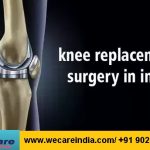Heart valve replacement Surgery in India
 If valve repair is not an option, your surgeon may choose to replace the valve. The native valve is removed and a new valve is sewn to the annulus of your native valve. The new valve can either be mechanical or biological.
If valve repair is not an option, your surgeon may choose to replace the valve. The native valve is removed and a new valve is sewn to the annulus of your native valve. The new valve can either be mechanical or biological.
Mechanical valve replacement Surgery in India
 Mechanical valves are made totally of mechanical parts which are tolerated well by the body. The bileaflet valve is used most often. It consists of two carbon leaflets in a ring covered with polyester knit fabric. There are advantages and drawbacks to mechanical valves.
Mechanical valves are made totally of mechanical parts which are tolerated well by the body. The bileaflet valve is used most often. It consists of two carbon leaflets in a ring covered with polyester knit fabric. There are advantages and drawbacks to mechanical valves.
If valve repair is not an option, your surgeon may choose to replace the valve. The native valve is removed and a new valve is sewn to the annulus of your native valve. The new valve can either be mechanical or biological.
 |
 |
| SJM Regent® Valve | St. Jude Medical® Mechanical Heart Valve |
The St. Jude Medical® Regent valve is available for aortic valve replacements, and the standard St. Jude Medical® valve is used in the aortic and mitral valve positions.
The St. Jude heart valve was the first bileaflet mechanical heart valve (St. Jude Medical® (SJM)). This valve has a track record spanning 3 decades of excellent results. This bileaflet mechanical heart valve is designed and manufactured of pyrolytic carbon.
 |
 |
CarboMedics manufactures a variety of bileaflet mechanical heart valves. The Top Hat Supra-Annular valve is used for aortic valve replacement and the standard valve in the mitral position. A third valve, the Reduce R Aortic Valve may also be used for aortic valve replacement.
The valve housing and leaflets are made of Pyrolite carbon, a unique form of carbon which Carbomedics engineers discovered in the sixties. Attached to the carbon housing is a reinforcing band of titanium and attached to the titanium band is a suture ring of PET fabric. A metallic nitinol wire holds the titanium ring to the housing with an interference groove system. Pyrolite is biocompatible.
- Advantages : – Mechanical valves are very durable. They are designed to last a lifetime.
- Disadvantages : – Due to the artificial material involved, patients who receive these valves require lifelong treatment with a blood-thinning (anticoagulant) medication. Blood-thinners are medications (such as warfarin or Coumadin) that delay the clotting action of the blood. They help prevent clots from forming on the mechanical valve, which can cause a heart attack or stroke.
Risks
The risks for any anesthesia include : –
- Problems breathing
- Reactions to medications
The risks for any surgery include : –
- Bleeding
- Infection
The risks for cardiac surgery include: –
- Death
- Heart attack
- Irregular heartbeat (arrhythmia)
- Kidney failure
- Stroke
- Temporary confusion after surgery due to the heart-lung machine
It is very important to take steps to prevent valve infections. You may need to take antibiotics indefinitely, or before dental work and other invasive procedures.
After the Procedure
The success rate of heart valve surgery is high. The operation can relieve your symptoms and prolong your life.
The death rate averages 2% to 5%, depending on the heart valve. About 2 of every 3 patients who received an artificial mitral valve are still alive 9 years after the surgery.
The clicking of the mechanical heart valve may be heard in the chest. This is normal.





